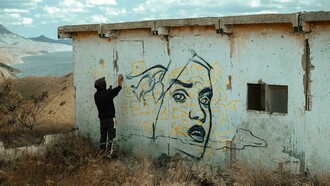We continue our journey through the projects of the fellows at the Real Academia de España in Rome.
Sera di festa in un sogno barocco (Evening party in a baroque dream) is the title of Irene-Clémentine Ortega's project which underlines how a costume, a dress, a garment can confer a transforming power to the wearer "by leaving everyday banality, playing with the established roles , breaking social rigidity." Ortega thus recreates the tableaux vivants of "an imaginary courtesan party, of an illusory banquet, of a festive bacchanal" highlighting the importance of customs and scenography in changing our point of view on the world.
Javier Pividal's installation L’anima oscura (The dark soul) is inspired by the figure of Pier Paolo Pasolini and is a real theory of darkness. The shadow, the dark, the night are necessary to see the light, the fireflies. The reference is the article on Pasolini's fireflies, written by a disappointed but also visionary Pasolini just before he was assassinated.
Una montagna di dati (A mountain of data) by Enrique Radigales "has to do with the landscape in an attempt to question the limits that separate the spheres of culture and nature, in which the animal, the vegetable, the human and its constructions artificial and socio-systemic coexist in the uncertainty of a post-biological frontier." With these assumptions, the artist proceeded to examine and classify Mount Testaccio, a mountain built artificially by man and which in any case has developed its own biology over time.
Palinsesto Basagliano by Pantxo Ramas offers a review of the artistic practices that developed in the context of the psychiatric de-institutional revolution in Trieste with the affirmation of full rights also for people with mental problems. By deepening the role of these artistic practices Ramas places the dignity, autonomy and emancipation of man at the center of artistic practice.
Adolfo Serra's project is inspired by the Sacred Wood of Bomarzo built by Vicino Orsini in the 16th century and aims to bring the Academy closer to the public of children and families. It looks like an experimental illustrated book, without words where the pages become real sculptures and the reader can build his own story by themselves. Reflecting on the park of Bomarzo Serra finds that even the forest can be included among the monsters. In many stories the forest is a place of transformation, the characters enter the forest and on that journey they become mature people.
Begona Soto analyzes the advent in Spain of the Italian Society of Cines, a film company born in Rome at the beginning of the 20th century. In Spain, Cines introduces itself underlining the Italian link with the fine arts in the cinematographic field, thus feeding a production of films related to famous Spanish literary works. Another important aspect of this "cultural revolution" is that cinema is presented as an art and as such taught in professional schools.
Vandali o poeti visivi (Vandals or visual poets) is the project of Claudio Sotolongo, a project that investigates the visual expressions of social dissent by offering a glimpse of the relationship between citizenship and power in a city, Rome, which in the minds of many people remains a city that succumbs to the weight of its great artistic heritage but which is actually contemporary like many other capitals, just change the eyes with which we look at it.
Eduardo Soutullo brought us into the world of music. Starting from the work of some composers of polychoral music from the 1500s and 1600s linked to Rome such as Orazio Benevoli and Giuseppe Ottavio Pitoni, Soutullo composed chamber music pieces with a contemporary language. The concert was held in the Church of San Pietro in Montorio.
Javier Verdugo Santos is an archaeologist who developed the project Archeology and power. Protection and conservation of the archaeological heritage of Rome from the Unification of Italy to the post-war period (1870-1945), a continuation of previous research always based on the study of the protection of the heritage of Rome.
The writer Manuel Vilas took advantage of the residence to conclude the novel he was working on, a novel where the idea of beauty represented by Rome but also from all over Italy becomes a form of personal redemption.
Starting from the consideration that Italy and Spain are privileged places for the study of theatrical events as the boundary between rituals and theatricality is very blurred Ana Zamora has ventured into the most primitive theatricality where theatre becomes a ritual to invoke the supernatural but also a space for relationships social.
Pagan and Christian rites that are transformed into a large party, now hopelessly touristic, exponent of a lost or perhaps dreamed world, which refers us to the ancestral meaning of scenic art. And in this panorama of mergers and confusions, the puppet was born as a great magic element, totemic, to be the protagonist of a theatre not regulated by rigid realist paradigms nor worried by anachronisms, as an art that accumulates all possible improbability.















